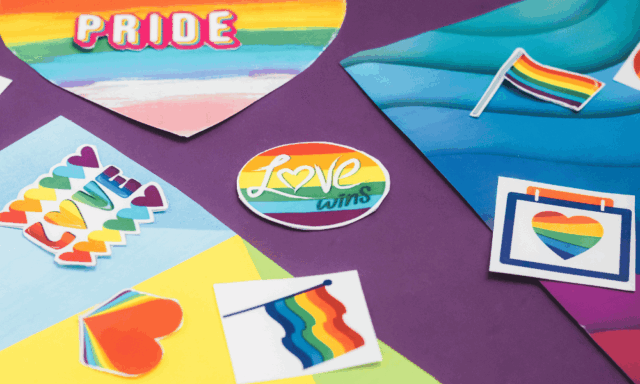Once few and far between, corporate engagement with Pride Month and LGBTQ+ communities more broadly has increased exponentially since the 1980s. As queer communities worked hard to normalize their existence, marketing campaigns that emerged alongside this progress helped to promote social acceptance. While some view this as a celebration of LGBTQ+ rights, less thoughtful iterations of Pride Month marketing have rightfully been criticized as “rainbow washing.”
This year marks one decade since the landmark Obergefell v. Hodges ruling, in which the Supreme Court struck down all bans on same-sex marriage nationwide. Now, in 2025, it’s customary for many major brands to flood social media and storefronts with rainbows. In support of Pride, companies increased engagement with queer communities both in voice by running Pride-themed ads, and in action, sponsoring Pride events and adopting internal policies to support and validate LGBTQ+ employees.
This year, under political and economic pressure, many brands have heavily scaled back their celebrations of Pride. From early visibility efforts to modern-day critiques, the journey of brand involvement in Pride tells a story of social progress, marketing missteps, and the growing expectations of inclusion. A widening disconnect between brand voice and action begs the question: When is corporate engagement in Pride meaningful, not just marketable?
The Emergence of Pride Marketing
Early marketing campaigns featuring queer visibility in the 1990s–2000s were bold, limited, and often risky. The alcohol and fashion industries were some of the first to market to queer audiences. These early campaigns ran during a time when popular sentiment was skewed against LGBTQ+ people, and brands knew there would be some backlash from anti-LGBT groups and conservative politicians. Still, as queer culture moved from a relatively obscure subculture into the public eye, early advertisements that depicted or referenced LGBTQ+ people were broadcast to broad audiences.
In 1986, Absolut vodka ran a campaign featuring artwork by famed artist and AIDS awareness activist Keith Haring, who was openly gay. In 1994, IKEA ran a famous commercial featuring a gay couple shopping for furniture. In the mid-90s, Subaru ran many pro-LGBTQ+ campaigns that earned the vehicle brand its deep association with lesbian culture that continues even today. One such ad featured the tagline: “It’s not a choice. It’s the way we’re built.”
By representing queer people in public-facing media, early Pride marketing helped increase visibility and normalize LGBTQ+ identities for mass audiences. For a marginalized community largely ignored or demonized by mainstream media, such representation was a display of cultural progress. These campaigns played an important role in shaping public perception and expanding societal acceptance, long before widespread legal and social recognition.
All Eyes on Pride
As social attitudes shifted in the 2000s and 2010s, corporations saw an opportunity. Pride Month morphed into a full-blown marketing season. Brands across the board from Apple to Nike embraced LGBTQ+ themes, launched rainbow-themed product lines, and sponsored parades. Pride-themed merchandise and rainbow logos became common across corporate America.
At its best, this commercial embrace expanded awareness and funneled support to LGBTQ+ nonprofits. At its worst, it veered into opportunism. In recent years, LGBTQ+ audiences and allies have become more vocal about demanding substance over symbolism. Pride campaigns are now scrutinized for authenticity, corporate policies, and year-round inclusion practices. Thus emerged the term “rainbow washing”: when a brand uses Pride imagery without demonstrating any meaningful support or accountability. Simply slapping a rainbow on a product or profile picture is no longer enough.
What’s Different this Year
This year is a bit different. Advertisers are feeling pressure when it comes to Pride Month this year. In the wake of high-profile political attacks against Diversity, Equity, and Inclusion (DEI) initiatives by the Trump administration, companies fear backlash from the Trump administration or conservative political leaders. At the same time, the president’s tariffs plan has caused many companies to scale back advertising spend across the board.
A recent poll from Gravity Research surveying 29 senior-level corporate executives indicated that 39% of U.S. respondents had walked back their external Pride communications, such as themed ads or event sponsorships. Another 14% indicated that they were also planning to scale down their internal LGBTQ+ engagement, like gender-affirming policies in the workplace. These actions have impacts that extend beyond the month of June.
As corporations turn their backs on Pride, consumers see the disconnect. For example, Twin Cities Pride, an organizer of an annual Pride parade in Minnesota, announced that it had turned down a $50,000 pledge from longtime sponsor Target in response to the corporation’s withdrawal from its DEI commitments. Consumers want alliance that shows a brand’s unwavering commitment to its ethical standards, yet external risks have caused many to feel uncertain about doubling down.
Pride marketing isn’t inherently bad, but it needs to go deeper than a simple logo palette swap. However, what brands once saw as an opportunity is now a double-edged sword. Political and economic pressure have caused some brands to rethink their Pride marketing plans, leading consumers to question whether there was any authenticity to these campaigns in the first place. Despite the challenges, the path forward lies in embracing transparency, listening to queer voices, and committing to real change.





